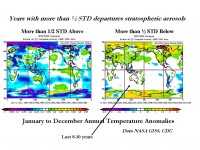By Joseph D’Aleo
Back in November, I posted this blog showing some evidence that a lack of volcanic ash may have contributed to the recent warmth especially in the polar regions. The temperature anomalies were shown in this pair of maps for high and low aerosol content.

See larger image here.
Annual Temperatures when Stratospheric Aerosol content is high as after a major volcano(s) (left) and low (right). Composites are for years where standardized globally averaged aerosol levels exceed 1/2 STD above or below long term average
Eugenio Hackbart of the Brazil Metsul called our attention to a new story in New Scientist Environment by David Shiga that provides support for that hypothesis. He notes:
Last month’s lunar eclipse not only treated skygazers to a ruddy view of the Moon - it revealed that Earth’s atmosphere contains little light-blocking volcanic dust. Some researchers say the low volcanic dust levels in the atmosphere over the last dozen years could be contributing to global warming, but others dispute the claim. During a lunar eclipse, Earth blocks sunlight from reaching the Moon directly. But some sunlight still gets through, refracted through Earth’s atmosphere. The amount varies, depending mainly on how much dust from volcanic eruptions is floating around at high altitudes. Because dust can block sunlight from passing through the atmosphere, more dust makes for a darker Moon during lunar eclipses. “All the big dimmings of the Moon during eclipses can be attributed to specific volcanoes,” says Richard Keen of the University of Colorado in Boulder, US.
Keen and his collaborators have charted the brightness of eclipses back to 1960 and for a few years around the time of the 1883 eruption of Indonesia’s Krakatoa volcano. The most recent lunar eclipse, on 20-21 February, was a bright one, measuring a 3 - the second-brightest level - on an eclipse-rating scale that ranges from 0 to 4. That is in line with eclipse data taken since 1995. In that time, the stratosphere has been especially clear, with very little haze-producing volcanic activity compared to the previous three decades, from 1965 to 1995, Keen says. Because more sunlight is reaching the surface, Earth should be 0.1 to 0.2° Celsius warmer in recent years than it was back in the late 1960s, Keen and his colleagues calculate.

See larger image here.
Susan Solomon of the US National Oceanic and Atmospheric Administration in Boulder, Colorado disputes Keen’s conclusions. The amount of haze in the stratosphere has been higher - blocking more sunlight - in the past 40 years compared to the 20 years before that, she says. So over the past 60 years, there would have been a slight cooling trend if volcanic haze were the only influence on climate, she says.
Keen acknowledges that depending on the period chosen, volcanic haze can give a cooling rather than a warming trend. But he argues that the relatively long period with a clear atmosphere since 1995 could be having a big impact on climate, especially if the extra sunshine reaching the Earth’s surface could create subtle, longer-term warming effects through the heating of ocean water, as some scientists propose.
Icecap Note: Solomon has been wrong before. She was a lead author of the latest IPCC Summary for Policymakers that greatly overstated the human greenhouse influence on climate. She was a leader in the ozone hole consensus a few decades back that may have collapsed. She is wrong again here. Keen was talking about the period since 1995 in which the volcanic aerosols have been as rock bottom levels not the last 60 years.




